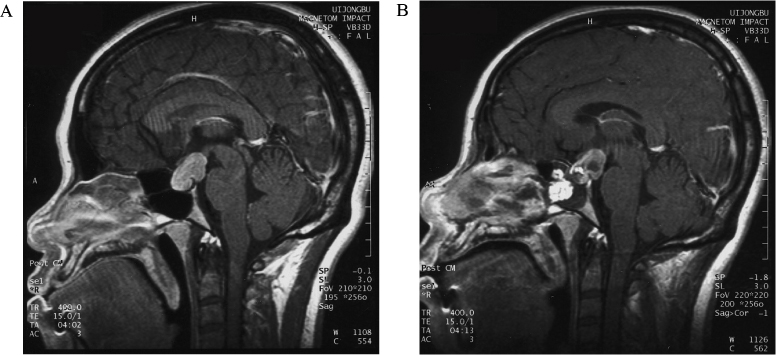J Korean Diabetes Assoc.
2006 Jul;30(4):312-315. 10.4093/jkda.2006.30.4.312.
A Case of Acromegaly Presenting with Diabetic Ketoacidosis
- Affiliations
-
- 1Division of Endocrinology and Metabolism, Department of Internal Medicine, College of Medicine, The Catholic University of Korea, Korea.
- KMID: 2177603
- DOI: http://doi.org/10.4093/jkda.2006.30.4.312
Abstract
- In patients with acromegaly, glucose intolerance and diabetes mellitus are one of the frequent manifestations. And the type of diabetes in these patients is usually non-insulin dependent type secondary to insulin resistance caused by growth hormone excess. Therefore, the diabetes mellitus in these patients dose not tend to develop diabetic ketoacidosis. But we experienced and presented the case of a patient with acromegaly hospitalized due to the diabetic ketoacidosis without overt clinical manifestations of acromegaly. This case of acromegaly showed that growth hormone excess could cause diabetic ketoacidosis in the presence of relative insulin deficiency.
MeSH Terms
Figure
Reference
-
1. Emmer M, Gordon P, Roth J. Diabetes in association with other endocrine disorders. Med Clin N Am. 1971. 55:1057–1064.2. Nabaro JDN. Acromegaly. Clin Endocrinol. 1987. 26:481–512.3. Bolinder J, Ostman J, Werner S, Arner P. Insulin action in human adipose tissue in acromegaly. J Clin Invest. 1986. 77:1201–1206.4. Hansen I, Tsalikian E, Beaufrere B, Gerich J, Haymond M, Rizza R. Insulin resistance in acromegaly: defect in both hepatic and extrahepatic insulin action. Am J Physiol. 1986. 250:E269–E273.5. Muggeo M, Bar RS, Roth J, Khan CR, Gordon P. The insulin resistance of acromegaly evidence for two alterations in the insulin receptor on circulating monocytes. J Clin Endocrinol Metab. 1979. 48:17–25.6. Dominici FP, Turyn D. Growth hormone-induced alterations in the insulin-signaling system. Exp Biol Med. 2002. 227:149–157.7. Chernick SS, Clark CM, Gardiner RJ, Scow RO. Role of lipolytic and glucocorticoid hormones in the development of diabetic ketosis. Diabetes. 1972. 21:946–954.8. Shade DS, Eaton RP. Pathogenesis of diabetic ketoacidosis: a reappraisal. Diabetes care. 1979. 2:296–306.9. Katz JR, Edwards R, Khan M, Conway GS. Acromegaly presenting with diabetic ketoacidosis. Postgrad Med J. 1996. 72:682–683.10. Abrahamson MJ. Death from diabetic ketoacidosis after cessation of octreotide in acromegaly. Lancet. 1990. 336:319–321.11. Szeto CC, Li KY, Ko GTC, Chow CC, Yeung VTF, Chan JCN, Cockram CS. Acromegaly in a woman presenting with diabetic ketoacidosis and insulin resistance. Int J Clin Pract. 1997. 51:476–477.14. Vidal Cortada J, Congnet Donlo JI, Navarro Tellez MP, Halperin Rabinovic I, Vilardell Latorre E. Diabetic ketoacidosis as the first manifestation of acromegaly. An Med Interna. 1995. 12:76–78.15. Alberti KG. Role of glucagon and other hormones in development of diabetic ketoacidosis. Lancet. 1975. 14:1307–1311.16. Ginsberg HN. Investigation of insulin resistance during diabetic ketoacidosis: role of counterregulatory substances and effect of insulin therapy. Metabolism. 1977. 26:1135–1146.17. Sheppard MC. Primary medical therapy for acromegaly. Clin Endocrinol. 2003. 58:387–399.


